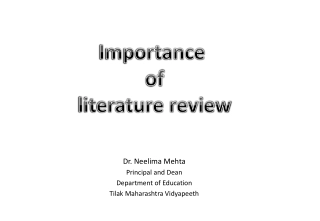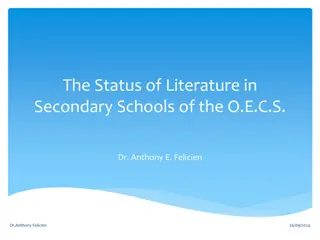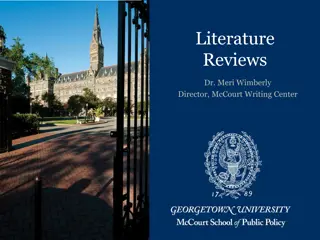Understanding Systematic Literature Review in Research
Systematic Literature Review (SLR) is essential in research to comprehensively collect and present findings on a specific topic. It is a structured approach that addresses quality issues and provides a consistent methodology for evaluating research studies. Contrasting with traditional reviews, SLRs are rigorous and methodical, ensuring a thorough examination of available information. SLRs play a crucial role in academic writing, guiding scholars in summarizing existing knowledge, formulating hypotheses, and laying the foundation for research projects.
Download Presentation

Please find below an Image/Link to download the presentation.
The content on the website is provided AS IS for your information and personal use only. It may not be sold, licensed, or shared on other websites without obtaining consent from the author. Download presentation by click this link. If you encounter any issues during the download, it is possible that the publisher has removed the file from their server.
E N D
Presentation Transcript
Systematic Literature Review (SLR) Prof. Dr. M. Haluk K ksal
Systematic Literature Review In research, there are different aims and situations in which scholars write a literature review. Typically, the aim of literature reviews is to summarize and integrate the existing knowledge about a topic (Rowley and Slack 2004). The situations where literature reviews are written and used are independent from the authors that deal with the topic. In broad terms, there are three main situations for writing a literature review: 1. A standalone review article of the literature for a specific topic. 2. An introduction to an empirical paper and foundation for hypotheses. 3. The first stage of a bigger research project (e.g. a dissertation).
Systematic Literature Review A SLR is more useful than a traditional literature review for a dissertation (especially at doctoral level). In empirical articles, on the other hand, a literature review does not need to answer a research question on its own; instead, it provides a short overview of the topic and helps to derive the main hypotheses of the paper. Therefore, a traditional literature review might in some cases be more suitable for empirical articles, where the main focus is not the literature review itself.
Where to start How to start Where and how to store How to use them How finding them And So many other issues
Systematic Literature Review is the key to overcome all these confusions and difficulties
Definition of Systematic Literature Review Is a scientific study designed to address a specific research question by comprehensively collecting all the information available on a topic that is defined at the outset by absolute inclusion and exclusion criteria. Is a systematic way of collecting, critically evaluating, integrating, and presenting findings from across multiple research studies on a research question or topic of interest. Is systematic since it adopts a consistent, widely accepted, methodology. The methodology should address concerns regarding quality issues, such asbias, replicability, credibility, etc.
Traditional Review vs. Systematic Literature Review Broadly speaking, the two most commonly known types of literature reviews are the traditional or narrative review and the gold standard or SLR. Traditional reviews, also known as conventional or nonsystematic reviews are generally faster and easier to conduct and are sometimes appropriate due to a short time frame or lack of resources. On the other hand, systematic literature reviews are more transparent, more replicable and reduces the risk of bias.
Systematic Literature Review Traditional Literature Review Identification for the need for a review article SLRs only make sense if there is a need for one. Traditional reviews are part of nearly every publication. Development of a review protocol It is essential for the objectivity of a SLR Not common for traditional reviews Identification of research papers It is a structured, replicable and transparent process It is a subjective process Evaluating studies It has a transparent protocol for elimination of the studies and the elimination process is objective There is no clarity for the exclusion of the studies. The author takes the literature that helps to support his/her hypotheses Conducting data extraction Driven by a general protocol Driven by the intuition of the authors Conducting data synthesis Concept driven; central part of an SLR Not necessary; resembles a summary of existing literature Reasons for a SLR Standalone paper, creates evidence and answer a research question To set a literature foundation for an upcoming empirical project, as individual paper (formerly)
Steps of Conducting SLR 1. 2. 3. 4. 5. Familiarize yourself with the PRISMA framework. Formulate your clear and unambiguous research question Identify the concepts to be included in you research. Define each term in the study question. Define relevant date sources (i.e. Web of Science or Scopus), typically no more than five. Develop a series of key words to be used for the search guided by terms that you defined in step 5. Decide inclusion and exclusion criteria. Define the limits that you will use. Go to each database individually to tailor your key words. Title review. Abstract review Abstract phase screening quality check Critical Review of full articles. Critical Review phase screening quality check Included studies Matrix Writing your report 6. 7. 8. 9. 10. 11. 12. 13. 14. 15.
Steps of Conducting SLR 1. Familiarize yourself with the PRISMA framework. PRISMA is an evidence-based minimum set of items for reporting in systematic reviews and meta-analyses. PRISMA focuses on the reporting of reviews evaluating randomized trials, but can also be used as a basis for reporting systematic reviews of other types of research, particularly evaluations of interventions.
Steps of Conducting SLR 2. Formulate your clear and unambiguous research question . This Allows you to find information quickly. Allows you to find information that is relevant and valid (accurately measures stated objectives). Provides you with a checklist for the main concepts to be included in your search strategy
Steps of Conducting SLR 3. Identify the concepts to be included in you research. Show at least three concepts of interest: 1. population(s) of interest: i.e. the research work dealing with ecosystem services in mountainous regions 2. Setting(s) of interest: i.e. the geographical distribution of existed studies, study distribution based on categories of mountain ecosystem services (MES) assessed. 3. Issue(s) of interest: i.e. trends of MES research, existing knowledge in MES studies, the challenges and gaps in MES
Geographical spread of the research
Steps of Conducting SLR 5. Define each term in the study question. Do not assume that any term is unequivocally understood either by the team members or by the readers. Mountain ecosystem AND services Mountain ecosystem services Mountain ecosystem AND synergies Mountain ecosystem AND initiatives Mountain ecosystem AND challenges
Steps of Conducting SLR 6. Define relevant data sources (i.e. Web of Science or Scopus), typically no more than five. It is a good idea to enlist the expertise of a reference librarian at this point.
Steps of Conducting SLR 7. Develop a series of key words to be used for the search guided by terms that you defined in step 5. Now finalize your plan for the systematic search. The first sub-step is to develop a series of key words to be used for the search.
Steps of Conducting SLR 8. Decide inclusion and exclusion criteria. Define the limits that you will use. Terms in the inclusion/exclusion criteria must also be defined. Define the limits you will use for your systematic search. Decide whether or not you will include gray literature (non-peer reviewed publications, dissertations, thesis, conference proceedings, etc.) and whether or not you will incorporate reference list searching (snowballing) or hand searches.
Inclusion and exclusion criteria Inclusion criteria Articles that document and focus on consumer experiences (CX). Articles that document business to consumer (B2C) experiences. Articles related to the retail experience. Articles published between 2010 and 2020. Articles written in English. Exclusion criteria Refer to CX in general and are not related to the retail area. Document experiences related to business to business (B2B), consumer to business (C2B) or consumer to consumer (C2C).
Phase Inclusion and exclusion criteria P1 Search based on final search string on major digital libraries to cover journal articles and conference papers P2 Excluding unpublished working papers, news articles and non- English articles P3 Excluding duplicate reports of the same study (removing duplicate reports that emerge due to the same search being performed in different electronic journal databases) P4 Excluding discussion papers, tutorial and prefaces P5 Excluding publications that were not truly related to CF technique and implicit feedback and did not contain the search strings P6 Excluding short papers (e.g. poster presentation, summaries of tutorials) as these papers cannot answer to the research questions as well P7 Review of full text papers and excluding studies that are not related to the research questions
Steps of Conducting SLR 9. Go to each database individually to tailor your key words. When used, they allow the researcher to search very specifically. This step has an ebb and flow to it as you develop your search terms and key words. Too specific and your search will yield nothing, too broad and your search will yield will be unmanageable. Use the key word generators within the database to create a formula of your search terms, using or, and as appropriate between terms.
Database search summary. Database Search syntax Total h ts Abstract read Full text downloaded PsycINFO Big Data Analytics , Healthcare Predictive Analytics , Healthcare Big Data Analytics , Health Management 16 16 3 9 9 0 20 20 2 PubMed Big Data Analytics , Healthcare Predictive Analytics , Healthcare Big Data Analytics , Health Management 263 263 35 86 86 12 15 15 3 Scopus Big Data Analytics , Healthcare Predictive Analytics , Healthcare Big Data Analytics , Health Management 587 587 36 194 100 4 17 17 3 Web of Science
Steps of Conducting SLR 10. Title review. Export choose articles to reference management software such as Zotero, EndNote, RefWorks, etc. Then into excel sheet. This is your Journal Citation Report (JCR). JCR includes; Author name, abstract, publication journal, DOI, volume, year of publication, etc.
Steps of Conducting SLR 11. Abstract review Up to this point you have screened only titles, so now you will begin to read through the abstracts of each article and screen them against the exclusion criteria. Instead of inserting yes or no, it is helpful to create separate columns for the two and insert a number 1 (for yes or for no, as applicable) so that you can run a sum total at the bottom of each spreadsheet to keep track of how many duplicates were removed, how many were excluded and how many were included per database. Once you have completed this for each separate database, create a tab for all included articles. Copy and paste all the included articles into this sheet and sort by title to quickly find and remove any remaining duplicates. This information will be important data for the PRIMSA flowchart.
Steps of Conducting SLR 12. Abstract phase screening quality check To strengthen validity and reliability for your search results, work with at least one other researcher to conduct an inter-rater instance, you can give the second reviewer 20% of the total number of abstracts you reviewed, randomly chosen, and leave your exclusion fields blank so that the second reviewer can run a parallel screening process on the subset of abstracts. Compare your findings aim for at least 90% agreement. Discuss disagreement with the third team until you reach an inclusion/exclusion agreement. reliability assessment. For and any areas of member reviewer
Steps of Conducting SLR 13. Critical review of full articles. Once you have the list of final included articles, conduct in-depth critical review of each article. Extract all relevant information from each article and insert in the appropriate place in the Excel document. As part of the critical review, rate the level of quality of evidence for each article using the framework you have adopted for your study.
Steps of Conducting SLR 14. Critical review phase screening quality check To strengthen validity and reliability for your critical review findings, work with at least one other researcher to conduct an interrater reliability assessment. For instance, you can give the secondary reviewer 20% of the total number of articles you critically reviewed, randomly chosen, and leave your assessment fields blank, so that the second reviewer can run a parallel critical evaluation process on the subset of articles. Compare your findings and aim for complete agreement. Closer the agreement to 100%, more robust is the critical review process. A level of at least 90% agreement may be acceptable. Discuss any areas of disagreement with the third team member.
Steps of Conducting SLR 15. Included studies Matrix Outcomes Methods Participants Year Level of Evidence First Author Assessments Results Settings
Steps of Conducting SLR 16. Writing your report
Reporting from SLR Not a simple additive task Interpret analysis of findings from multiple studies.
Reporting from SLR - Abstract - Introduction - Method - Results - Discussions - Conclusion - Reference - Appendix
Reporting from SLR (Abstract) Background, objectives, data sources, study eligibility criteria, Participants, study appraisals and synthesis methods, results, limitations, conclusions and implications of key findings and inclusion of SLR registration number if applicable
Reporting from SLR (Introduction) What is the SLR question? What was already known on the topic/question of interest? What drove the need for conducting this specific SLR? What is the objective of this SLR? What is the importance of this SLR study?
Reporting from SLR (Method) Team composition How many investigators were on the team? What were their qualifications, expertise, and levels of experience?
Reporting from SLR (Method) Search preparation What databases were targeted? What key words/phrases were used in each database search? What were the inclusion and exclusion criteria?
Reporting from SLR (Method) Search Process - How and when were the database searches conducted? How many phases of search were involved? - How we exclude/include specific publications? - What was involved in each steps
Reporting from SLR (Method) Critical Review - How it was conducted? - What information was extracted? - The quality level of each study determined - Used framework and method
Reporting from SLR (Result) Description of final list - How many articles were find in each step? - How many were retained in each step? - The final number of articles the critical review were performed
Reporting from SLR (Result) Content of final list - How many articles were empirical/rational an experimental? - How many were qualitative/quantitative? - What were the key finding? - The level of quality of each articles
Reporting from SLR (Discussion) - What new information was generated from this systematic review? - What is the general level (quality and magnitude) of evidence in various thematic areas? - Which of the areas enjoy higher quality/or magnitude of evidence? - Which areas currently lack quality and/or magnitude of evidence?
Reporting from SLR (Limitations and future studies) - What are the limitations of this SLR? - What topics/questions should be examine in future studies?
Reporting from SLR (Conclusion) - What are the key messages of this SLR for your target readers? (Reference) (Appendix)
References Booth, Sutton, & Papaioannou, (2016), Systematic Approaches to a Successful Literature Review. Sage , London . ISBN 9781473912465 Guillaume, L. (2019), Systematic literature reviews: an introduction, International Conference On Engineering Design, Iced19, 5-8 August, Delft, The Netherlands Huelin, R., Iheanacho, I., Payne, K. & Sandman, K. What s in a name? systematic and non-systematic literature reviews, and why the distinction matters, https://www.evidera.com/wp-content/uploads/2015/06/Whats-in-a- Name-Systematic-and-Non-Systematic-Literature-Reviews and Why-the Distinction Matters.pdf Kraus, S., Breier, M. & Das -Rodr guez, S. (2020), The art of crafting a systematic literature review in entrepreneurship research, Int. Entrep. Manag. J., 16(3), 1023 1042. Pati, D. & Lorusso, L. N. (2018), How to write a systematic review of the literature, Health Environments Research, & Design Journal, 11(1), 15-30. Robinson, P. & Lowe, J. (2015), Literature reviews vs systematic reviews, Australian and New Zealand Journal of Public Health, 39(2), 102-103. Xiao, Y. & Watson, M. (2019), Guidance on conducting a systematic literature review, Journal of Planning Education and Research, 39(1), 93-112























